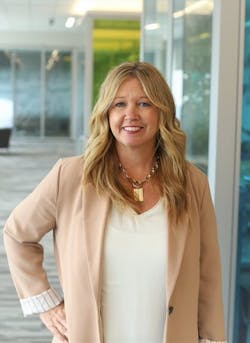Is Your Company A Cool Place to Work?
Rachael Conrad knows a thing or two about both attracting and retaining workers. Employed at Rockwell Automation for 24 years, she has seen a lot. Currently a vice president and general manager of Global Services at the company, she says sometimes she feels like a career counselor.
“I think people seek me out as I have been with the company so long and my career has allowed me to develop a variety of skills,” she says. “I love the people I work with and I love the company mission.”
Branding Matters
Translating her enthusiasm into a well-defined brand is how the company retains current talent and also attracts new talent. “Our company, and the manufacturing companies we serve, are all aware that branding the industry as a cool place to work, is a bit of a heavy lift,” says Conrad. “Companies might not think that much about their brand, but it’s important to demonstrate the impact that this sector has on society in a broad sense.”
In addition to how the sector is able to affect society on a number of fronts, it’s also a place where technology is being used to build the products of the future. And that offers a strong narrative, which needs to be publicized. “We need people with advanced skills,” she points out. “We need to emphasize that this work is fun and meaningful. We have to connect all of these things when reaching out to future workers.”
Training to Stay Relevant
While attracting future workers is essential, especially given the fact that the industry now requires different skills and this trend will continue, it’s also important to reskill current employees.
“As roles change we need to look for ways to shift people to adjacent or even different skill sets to perform other jobs,” says Conrad. “We don’t want to lose valuable people who understand our company and are happy with our culture.”
Conrad notes that the industry, which has faced a number of challenges over the past few years, has not always planned well for these skills shifts. “We need to start looking out three, five and ten years in advance and determine what skills will be necessary. And we need to take those actions now, especially with the high numbers of retirees we are expecting. While we might see a return on the investment in time and resources in reskilling for the next three years, we also have to invest for the future even if we won’t see a payoff for years.”
One framework to view talent management is through the same continuous improvement lens that the industry uses for efficiency of processes. And one of the best examples of that is how companies had to adapt due to the pandemic. “The pandemic helped us get creative. We have a lot of people that normally would go to customers’ sites such as engineers. When that couldn’t happen, they had to learn to do remote troubleshooting,” says Conrad.
And creating a more robust remote framework opened up opportunities to think about how to use the skills of those people in the company, for example, who might be retiring. “We can offer those people jobs doing remote problem-solving. This way they won’t have to travel and it would be a lighter workload. We have so many continuous improvement projects that offering this type of working arrangement will allow us to retain the knowledge of our seasoned workers.”
Culture is Key
In addition to retaining these talented workers, there needs to be a process to transfer knowledge. “We have seen that our older workers are very committing to ensuring that their knowledge gets passed along,” notes Conrad. The company will often pair, for a year, a young worker with one who is planning to retire. “This arrangement is a type of apprenticeship and that’s especially important in how our culture is passed from one generation to the next.”
One important aspect of the company's culture is transparency. “When you are transparent, people trust you. And that goes both ways. You have to be able to trust that you have the right employee for the role,” Conrad notes.
Ensuring an employee fits the role starts at the beginning of an employee's career. “On day one, we talk about the monument that the employees want to build. We talk about what success looks like to them. It’s not time-bound, it’s achievement-bound. We match their goals with the duties of the particular jobs,” says Conrad.
Conrad provides a great analogy for how to view this process. “If someone is at a stoplight and asks me which way to go, the answer I give depends on where the person wants to go. That’s true with your career. If you don’t know where you want to go then it’s hard to plan a course. So first you need to talk about the employee’s interests and what impact they want to make. What types of things do they want to learn and then work together to make a path that avoids roadblocks and manages detours."
Once on a career path, the discussion revolves around building new technical or management skills. "There is always something to be learned and ways to improve skills. This is an important part of employee engagement. Employees need coaching and the tools to achieve. We need to make sure that our talent is nurtured into how they want to grow,” says Conrad.
Checking in is done through what she called stay interviews. “We check in with people to make sure things are going well and they are able to follow the career path they want to. Finding out at the exit interview what could have been done to prevent someone from leaving isn’t a good tactic.”
Retention
Rockwell's workplace planning contributes to a strong retention rate, which is an important metric for the company. In North America the average attrition rate of 33.7%. Attrition rates in the U.S. increased by 30% in 2021 compared to that in 2020. Breaking that number down with regard to tenure, the highest attrition is observed for employees between one and two years of tenure across both the tech and automation fields.
One reason for the lower retention rates in the early years is that development plans must be personalized. “While 80% of a career development would be similar across our company, 20% is based on individual wants. Those preferences could be based on their age, personal goals, or even what’s happening in the market.”
One way Rockwell is recognizing individual preference is through their very specific action plans around diversity and inclusion. While the company has been active in this space for years, they are even more intent, over the past few years, to ensure that they hold themselves accountable to their stated goals. “We are bringing in people from all parts and levels of the organization and having discussions. We make sure that we are seeing different people in different seats, and we appointed our first diversity officer last year.”
This emphasis on D&I will help the company as it continues to seek talent. While the company has strong retention rates, it is always adding new roles with new skill sets and those jobs are harder to fill. And that’s where the brand comes in. “We have to have a compelling brand. Potential employees need to say, I love your vision and I want to come work with you,’ says Conrad.

